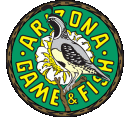Location
States
New MexicoEcosystem
Forest, River/streamIntroduction
Gila Trout (Oncorhynchus gilae) is a threatened trout native to the Gila and San Francisco River Basins in New Mexico and Arizona. Gila Trout are one of only three native trout species in New Mexico and Arizona, joining Rio Grande Cutthroat Trout (Oncorhynchus clarkii virginalis) in New Mexico and Apache Trout (Oncorhynchus apache) in Arizona. Federally listed as endangered in 1967, Gila Trout were reclassified as threatened in 2006 as a result of recovery efforts that helped recover populations. The species has five genetically distinct lineages remaining today (Main Diamond Creek, South Diamond Creek, Whiskey Creek, Iron Creek, and Spruce Creek). In this context, a genetic lineage is a population of a species with unique genetic data that differentiates it from other populations of the same species. Gila Trout populations have decreased mainly due to wildfires and habitat loss, but former pressures like overfishing, competition with non-natives, and hybridization have also played a role in their decline. The Spruce Creek lineage has experienced the worst of these impacts, making it a high priority for conservation efforts. Conservation is led by the U.S. Fish and Wildlife Service’s Gila Trout Recovery Plan with help from the New Mexico Department of Game and Fish (NMDGF), Arizona Game and Fish Department (AGFD), U.S. Forest Service, and the University of New Mexico (UNM). To conserve the Spruce Creek lineage, conservation efforts involve back-crossing, a form of breeding that introduces new genetic material from a related population with high genetic diversity to produce hybrids; the hybrids are then back-crossed, or bred, with pure individuals from the population low in genetic diversity.
Key Issues Addressed
Wildfires are the greatest threat to Gila Trout due to their impacts on habitat quality. The 2012 Whitewater-Baldy Complex Fire in the Gila National Forest destroyed nearly half of existing Gila Trout populations, most notably the Spruce Creek lineage of which approximately 96 trout was rescued and transferred to Mora National Fish Hatchery. Wildfires degrade Gila Trout habitat quality by removing vegetation and depositing sediment and ash into streams, which alters flows and decreases stream oxygen below levels necessary for Gila Trout survival. This makes it difficult to find suitable habitat for Gila Trout releases, as much of their native habitat is degraded and new habitat cannot be easily created in remote wilderness. The Spruce Creek lineage has extremely low genetic diversity, and researchers do not have enough Spruce Creek trout to use for back-crossing because there are few of them in the wild and they are difficult to maintain in the hatchery. The Spruce Creek lineage experiences the highest mortality rate and lowest reproductive success in captivity of the five lineages. Remaining Gila Trout populations in the wild have low genetic diversity and depend on remote stream systems in fire-threatened forests across New Mexico and Arizona. Recovery of this species is therefore a multi-step effort that depends on multiple agencies and hatchery personnel.
Project Goals
- Maintain all five lineages of Gila Trout at Mora National Fish Hatchery that are genetically diverse while restoring genetic diversity of the Spruce Creek lineage through back-crossing
- Provide Gila Trout to New Mexico and Arizona for both recovery efforts and utilize surplus fish for sport fishing programs
- Support efforts to promote self-sustaining populations in the wild that will move the species toward delisting from the Endangered Species Act
Project Highlights
Unique Origin: The Spruce Creek lineage’s genetic material is unique in comparison to the other four because it is the only lineage originating from the San Francisco River Basin.
- Back-Crossing Spruce Creek Gila Trout: The back-crossing process began in 2016 by breeding Spruce Creek females with Whiskey Creek males that had high genetic diversity to create hybrids. Back-crossing, or breeding, of these Spruce-Whiskey Creek hybrids with pure Spruce Creek trout began in 2020. Spruce-Whiskey Creek hybrids are bred every year to be back-crossed into the pure Spruce Creek population.
- Returning Gila Trout to Native Streams: Due to size constraints, Gila Trout are spawned in the spring and transported to native streams in the fall of the same year. Fish must be stocked in the same year before they outgrow small streams of their native waters. The Mora National Fish Hatchery is experimenting with stocking fertilized eggs in native streams because it is easier to transport eggs into these remote locations.
- Stocking Recreational Waters: Under the 4(d) rule of the Endangered Species Act, researchers can stock Gila Trout into recreational waters despite their threatened status. This rule enables the NMDGF and AGFD to establish special regulations in conjunction with the FWS to allow for recreational fishing of Gila Trout. Managers provide surplus fish not stocked in native streams or kept to maintain hatchery fish populations for sport fishing
- Multi-Agency Effort: Many different agencies are involved throughout the recovery process. Back-crossing efforts involve Mora National Fish Hatchery and the USFWS Southwestern Native Aquatic Resources and Recovery Center; the recovery team had help from the UNM, USFWS, and many others; and the NMDGF and AGFD are involved with stocking native streams and recreational waters for fishing.
Lessons Learned
Back-crossing is a time intensive process that requires patience. This project began in 2016 and results remain preliminary. Breeding is targeted for three-year-old hybrids, meaning that managers had to wait three years to begin the back-crossing process.
Managers learned that each of the five lineages of Gila Trout requires unique management due to variability in genetics and survival in both the hatchery and in the wild. Back-crossing for the Spruce Creek lineage is a good example. Back-crossing was required for this lineage only because they were decimated by the 2012 Whitewater-Baldy Complex Fire, with remaining wild populations exhibiting extremely low genetic diversity.
Conservation of rare fish should include co-management of both wild and hatchery populations. Keeping a pure Spruce Creek population alive in the hatchery was more difficult than expected, so managers needed to be aware of the number of wild individuals.
Early generations of Spruce-Whiskey Creek hybrids are exhibiting higher survival rates in the hatchery than the pure Spruce Creek trout. It is still too early to conclude the results of back-crossing efforts, but these initial results provide hope for future progress and success.
Multi-agency collaboration has been critical to the ongoing program success. This project requires a multitude of people and agencies working together to move forward with adaptive decision-making. Hatchery personnel at Moral National Fish Hatchery and geneticists from the USFWS Southwestern Native Aquatic Resources and Recovery Center have been vital in back-crossing efforts; the recovery team includes individuals from USFWS, NMDGF, and UNM; and the NMDGF and AGFD stock native streams and recreational waters for fishing. Together, these people and agencies have been instrumental in Gila Trout recovery.
Next Steps
- Continue back-crossing efforts with the Spruce Creek lineage to increase genetic diversity and increase population numbers.
- Create strategies to make up for the lack of pure Spruce Creek trout in the hatchery to sustain current back-crossing efforts.
- Monitor streams in the Apache-Sitgreaves, Gila, and Tonto National Forests to find suitable habitat for Gila Trout reintroductions.
Funding Partner
- U.S. Fish and Wildlife Service
Resources
- https://thefisheriesblog.com/2021/01/11/gila-trout/
- https://www.wildlife.state.nm.us/fishing/native-new-mexico-fish/gila-trout-recovery-angling/
- USFWS New Mexico Fish and Wildlife Conservation Office
Contacts
- Wade D. Wilson, Deputy Center Director and Geneticist, Southwestern Native Aquatic Resources and Recovery Center, U.S. Fish and Wildlife Service: wade_wilson@fws.gov
- Trevor Luna, Project Leader, Mora National Fish Hatchery, U.S. Fish and Wildlife Service: trevor_luna@fws.gov
CART Lead Author
Brianna Flood, CART Intern, Northern Arizona University
Suggested Citation
Flood, B., M. (2021). “Back-Crossing for Gila Trout Recovery in New Mexico” CART. Retrieved from https://www.fws.gov/project/back-crossing-gila-trout-recovery.










